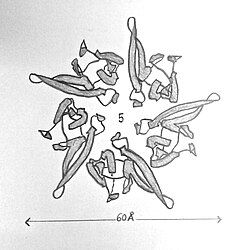Biology:Nucleoplasmin
From HandWiki
Short description: InterPro Family
| Nucleoplasmin family | |
|---|---|
 Illustration of the structure of nucleoplasmin | |
| Identifiers | |
| Symbol | NPM |
| InterPro | IPR004301 |
Nucleoplasmin, the first identified molecular chaperone[1] is a thermostable acidic protein with a pentameric structure. The protein was first isolated from Xenopus species[2][3][4]
Functions
The pentameric protein participates in various significant cellular activities like sperm chromatin remodeling, nucleosome assembly, genome stability, ribosome biogenesis, DNA duplication and transcriptional regulation.[4][5] During the assembly of regular nucleosomal arrays, these nucleoplasmins transfer the DNA to them by binding to the histones. This reaction requires ATP.[2][6][7][8]
Human proteins
Humans express three members of the nucleoplasmin family:
- Nucleophosmin (NPM1)
- Nucleoplasmin 2 (NPM2)
- Nucleoplasmin 3 (NPM3)
References
- ↑ "Nucleoplasmin: the archetypal molecular chaperone". Seminars in Cell Biology 1 (1): 11–17. February 1990. PMID 1983266.
- ↑ 2.0 2.1 "Nucleoplasmin-mediated decondensation of Mytilus sperm chromatin. Identification and partial characterization of a nucleoplasmin-like protein with sperm-nuclei decondensing activity in Mytilus californianus". Biochemistry 34 (23): 7563–7568. June 1995. doi:10.1021/bi00023a001. PMID 7779801.
- ↑ "A polypeptide domain that specifies migration of nucleoplasmin into the nucleus". Cell 30 (2): 449–458. September 1982. doi:10.1016/0092-8674(82)90242-2. PMID 6814762.
- ↑ 4.0 4.1 "Nucleoplasmin, an Important Nuclear Chaperone". Chinese Journal of Biochemistry and Molecular Biology 23 (9): 718–723. 2007. http://cjbmb.bjmu.edu.cn/EN/abstract/abstract17664.shtml.
- ↑ "New insights into the nucleophosmin/nucleoplasmin family of nuclear chaperones". BioEssays 29 (1): 49–59. January 2007. doi:10.1002/bies.20512. PMID 17187372.
- ↑ "Nucleoplasmin-like core domain superfamily". Superfamily 1.75, HMM Library and Genome Assignment Server. http://supfam.org/SUPERFAMILY/cgi-bin/scop.cgi?sunid=69203.
- ↑ "The intrinsically disordered distal face of nucleoplasmin recognizes distinct oligomerization states of histones". Nucleic Acids Research 42 (2): 1311–1325. January 2014. doi:10.1093/nar/gkt899. PMID 24121686.
- ↑ "Nucleoplasmin family". InterPro. EMBL-EBI, Wellcome Trust Genome Campus,European Molecular Biology Laboratory. http://www.ebi.ac.uk/interpro/entry/IPR004301.
Further reading
- "Nucleoplasmin remodels sperm chromatin in Xenopus egg extracts". Cell 69 (5): 759–767. May 1992. doi:10.1016/0092-8674(92)90288-n. PMID 1591776.
- "The role of nucleoplasmin in chromatin assembly and disassembly". Philosophical Transactions of the Royal Society of London. Series B, Biological Sciences 339 (1289): 263–269. March 1993. doi:10.1098/rstb.1993.0024. PMID 8098530.
 |

